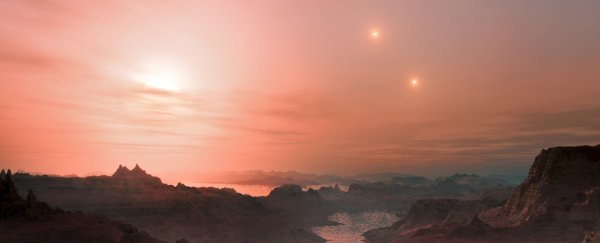Our Sun is a lone wolf of a star, but out there in the wider Universe, stars are often locked in a dance with others, orbiting a mutual centre of gravity. In one such triple-star system, astronomers have just found an exoplanet.
It has the rather catchy name LTT 1445Ab, as it orbits the primary star of three red dwarfs that constitute the system LTT 1445, located around 22.5 light-years away.
"If you're standing on the surface of that planet, there are three suns in the sky, but two of them are pretty far away and small-looking," astronomer Jennifer Winters of the Harvard-Smithsonian Center for Astrophysics told New Scientist.
"They're like two red, ominous eyes in the sky."
Her team's research has been submitted to The Astronomical Journal, so we can expect it to be peer-reviewed soon.
The planet was discovered by TESS, NASA's planet-hunting space telescope designed to find exoplanets that pass between us and their home star, by detecting the telltale dimming as the planet blocks a small percentage of the star's light.
The depth of dimming, and the tiny movements of the star as it is very slightly pulled by the planet's gravity (detected with other telescopes), allow scientists to place constraints on the size and mass of the planet.
LTT 1445Ab is very different from the 2016 discovery of HD 131399Ab, another exoplanet with three suns. The latter is a giant with a 550-year orbit around one of the stars in a triple system 340 light-years away.
The new planet only clocks in at about 1.35 times the physical size of Earth. Into that size, it packs up to 8.4 times Earth's mass, so it's a lot denser than our home planet.
Although this size and mass places it firmly into the rocky category - like Earth, Venus and Mars, as opposed to gas or ice giants - and although it would be home to a lot of really spectacular skies, chances of habitability are probably pretty low.
The exoplanet whips around its star just once every 5.36 Earth days. At such a close proximity, its surface temperatures would be a scorching 428 Kelvin (155 °C; 311 °F).
Even so, astronomers are excited about taking a closer look. That's because LTT 1445Ab might have an atmosphere - and rocky planets with atmospheres that orbit in front of their stars are good places for us to test the detection tools we use to look for gases such as methane and carbon dioxide.
A planet with an atmosphere wouldn't just dim the star's light, but also change it based on the atmosphere's chemical composition. Specifically, scientists can analyse changes in the star's light spectrum to piece together that composition.
Our currently active technology isn't very well suited to this, but hopes are high for the successor to Hubble, the James Webb Space Telescope. It's due to be launched in 2021, and astronomers are eagerly identifying and picking out targets they'd like it to study.
LTT 1445Ab could be a perfect candidate. Because it transits so often, there will be plenty of opportunities for observations. It's only 22.5 light-years away - relatively close, in cosmic scales. Its red dwarf star is bright enough to back-light the atmosphere, but not so bright that the planet is completely outshone.
And, even if it doesn't have an atmosphere, or if its atmosphere contains no biosignatures, rocky planets are relatively common in close orbit around red dwarf stars. So taking a closer look at LTT 1445Ab could tell us more about what we can expect to find on such planets.
The paper has been submitted to The Astronomical Journal, and is available on arXiv.
